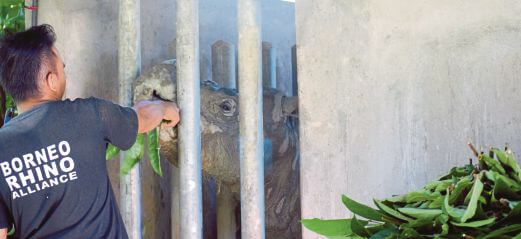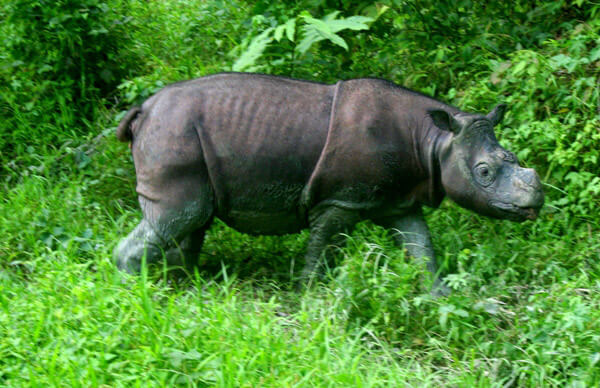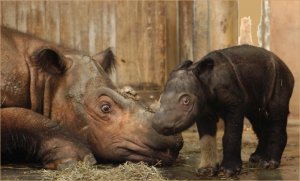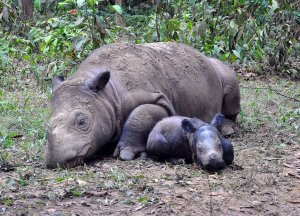For those with an interest in conservation history, here is a collection of historic correspondence from the 1980s, a period when the best course of action to conserve the Sumatran rhinos in Borneo was being actively discussed. Regrettably, it did not result in the timely intervention which may have made the critical difference to the survival of this species.
Critically endangered species: Fewer than 100 Sumatran rhinos left
 NST Online 18 Dec 2016 by Olivia Mivil: ALL the remaining Sumatran rhinos in Malaysia and Indonesia, which number less than 100, should be managed as a single population to facilitate the reproduction of the critically-endangered species.
NST Online 18 Dec 2016 by Olivia Mivil: ALL the remaining Sumatran rhinos in Malaysia and Indonesia, which number less than 100, should be managed as a single population to facilitate the reproduction of the critically-endangered species.
Sabah Wildlife Department director Augustine Tuuga says discussions with the department’s Indonesian counterpart was underway to cooperate on rhino breeding. He says government is committed to conserving the critically endangered species. “In-vitro fertilisation requires experts and high technology to increase the success rate. “For now, we are relying on expertise from Germany, and the cost for each fertilisation attempt is about RM300,000.” To support the effort, the Federal Government has allocated RM11.9 million for advanced reproductive technology for rhinos.
Read the article on NST Online : http://www.nst.com.my/news/2016/12/197796/critically-endangered-species-fewer-100-sumatran-rhinos-left
Cash-strapped rhino groups turn to crowdfunding, with little success
In a desperate effort to stave off the extinction of Bornean and northern white rhinos, conservation groups in Malaysia and Kenya are appealing to the public to fund high-tech assisted reproduction efforts. / Jeremy Hance

Introduction from BORA: Many thanks to Jeremy Hance and Mongabay for yet again playing an important role in drawing attention to the Sumatran rhino. I would like to highlight two points. Sumatran rhino represents a genus, not a sub-species. Without new action, Dicerorhinus sumatrensis will be the first terrestrial mammal genus to go extinct since the thylacine in 1936. We should no longer continue with the idea of keeping the Sumatran and Bornean forms separate, but treat them as one species to be saved under one program to boost births of the genus.
Secondly, whatever happens with the now non-viable Bornean sub-species and to Borneo Rhino Alliance, Indonesia has to step up with a genus recovery program that incorporates Indonesian and Malaysian rhinos, and Bornean and Sumatran sub-species. Without that, Indonesia will take the blame when the genus does go extinct, under current trends around 2030. However, the Government of Indonesia should not take the blame. It is about time that IUCN, WWF, International Rhino Foundation and Indonesian Rhino Foundation give rational, consistent, clear and scientific advice to Government of Indonesia on exactly what needs to be done. Funds urgently need to be allocated to serious efforts to save the genus.
________________________
Cash-strapped rhino groups turn to crowdfunding, with little success
There’s probably only one thing left that can save the Bornean rhino (Dicerorhinus sumatrensis harrissoni): cutting-edge, high cost in vitro fertilization (IVF) technology. This subspecies of the Critically Endangered Sumatran rhino is represented by a dwindling handful of survivors in the wild – one of whom just perished when conservationists tried to move her this year – and three individuals living in captivity. The captive rhinos, one male and two females, are incapable of natural reproduction due to fertility problems. Extinction is on the horizon unless IVF is able to start producing rhino babies – and fast.
The technical difficulties are high – including the fact that IVF has never been successfully done with any of the world’s five rhino species – but the biggest hurdle may actually be something much more prosaic: money.
“Donors want to be assured that the animal will not go extinct on them in the next few years,” said John Payne, the executive director of the Borneo Rhino Alliance (BORA). “It is much safer to put money into a threatened species than it is to put money into a species that is on the edge of extinction.”
Read the full article on Mongabay
The struggle to breed Sumatran rhinos in captivity (Articles from Mongabay)
Mongabay has published two articles on Sumatran rhino which summarise nicely the story of attempts to save the genus from extinction. Wisely, the articles leave out the doomed attempts (still supported by many conservationists) to keep these rhinos in the wild, knowing that each scattered sub-population was and is too small to ensure survival.
Part 1: From Indonesia to Ohio: the struggle to breed Sumatran rhinos in captivity
By Linda Lombardi
3 November 2016

In a desperate attempt to reverse a rapid population decline, a captive breeding program for Sumatran rhinos was launched in 1984. Forty rhinos were successfully moved to zoos and sanctuaries, but researchers soon found their troubles were just beginning. (Read the whole article on Mongabay)
8 November 2016

With the last of the American-born Sumatran rhinos now living in Indonesia, chances for this critically endangered species are once again firmly rooted in Southeast Asia. Meanwhile, researchers in Malaysian Borneo are in an even more desperate race against time. (Read the whole article on Mongabay)
BORA Channel on Youtube
See more videos on the Borneo Rhino Alliance Channel
- « Previous Page
- 1
- …
- 3
- 4
- 5
- 6
- 7
- …
- 20
- Next Page »